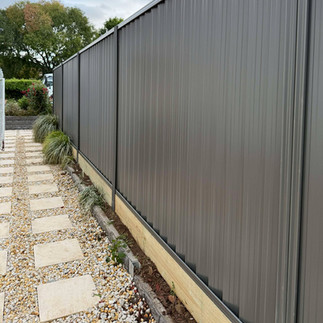Why We Don’t Use Concrete Sleepers Under a Fence
- Glovers Fencing

- 3 days ago
- 3 min read
At Glovers Fencing, we’re often asked whether concrete sleepers can be used under a Colorbond fence. While they might seem like a stronger or more durable option, concrete sleepers aren’t suitable for standard fencing setups and there are several good reasons why we don’t use them.
Here’s what you need to know about why we stick with the right materials for the right job.
What Concrete Sleepers Are Designed For:
Concrete sleepers are heavy, reinforced panels built for retaining walls, not fencing. They’re designed to sit inside steel H-beam posts, which are engineered to handle soil pressure and weight. In a retaining wall, that setup works perfectly — the beams and sleepers work together to hold back tones of soil safely.
A fencing system, however, is completely different. Colorbond fencing uses C-posts, which aren’t built to carry that kind of load or accommodate the shape of a concrete sleeper.
Engineered retaining wall
Why Concrete Sleepers Don’t Work Under a Fence:
1. They’re too heavy for fence posts - Each concrete sleeper can weigh 40–80 kg, depending on length and thickness. That’s far beyond what standard fence posts are designed to support.
Using them adds unnecessary load, which can cause posts to twist, bow, or pull out of alignment over time.
2. They don’t fit properly into C-posts - C-posts are made to suit timber sleepers or aluminum bases — materials that slide neatly and securely into the post recess. Concrete sleepers are thicker, less forgiving, and can’t sit properly in those channels. Trying to force them in risks cracking the post or leaving gaps that allow movement, compromising the fence’s strength and appearance.
3. They can cause long-term structural issues - A fence line isn’t engineered like a retaining wall. When you mix the two systems — retaining components with fencing hardware — you introduce stress points the system wasn’t designed to handle. Over time, that can mean post movement, cracks at the base, or even premature failure of the fence.
4. They make installation more complex (and costly) - Because of their weight, concrete sleepers require lifting equipment or multiple installers to handle safely. They’re also harder to align perfectly on a long fence run. For something that provides little to no benefit in this context, the extra labour and material cost just isn’t worthwhile.
What We Use Instead:
For fences that need a small retaining base or to prevent soil contact, we use:
Treated pine sleepers (H4) — lightweight, durable, and designed for ground contact.
Aluminium bases — perfect for clean lines and termite resistance.
Proper retaining wall systems — if the site actually needs to hold back soil, we’ll identify that early and recommend contacting a landscaper for an engineered wall instead of a fence trying to do both jobs
This approach ensures the structure remains safe, straight, and compliant, and that each component performs the job it was designed for.
When a Retaining Wall Is the Right Choice:
If your boundary line needs to hold back more than a small amount of soil, that’s when a proper retaining wall should come into play. Once the wall is built (by a landscaper or retaining specialist), we can install your fence neatly on top of the wall — giving you both the function and finish you’re after, without compromising either system.
In Summary
We don’t use concrete sleepers under fences because:
They’re too heavy for standard fencing posts
They don’t fit correctly in C-posts
They can cause movement and structural issues over time
They make installation unnecessarily complex and expensive
At Glovers Fencing, we prefer to use materials designed for the purpose — ensuring your fence stays strong, straight, and built to last.
If you’re unsure what your site needs — a standard sleeper base or a retaining wall — we’re happy to take a look and give you honest advice.













Comments